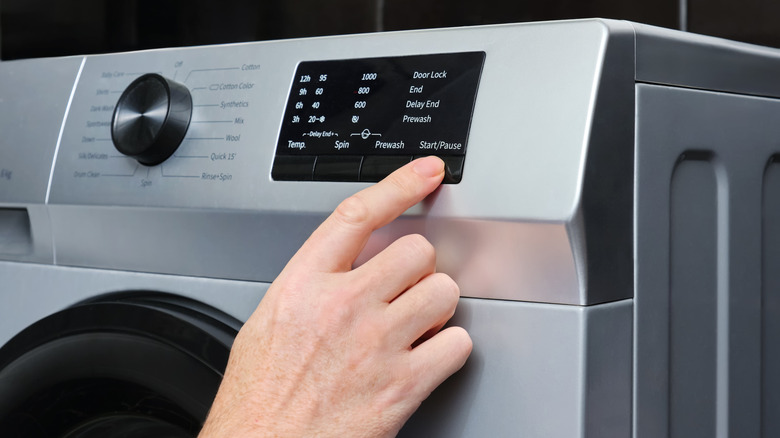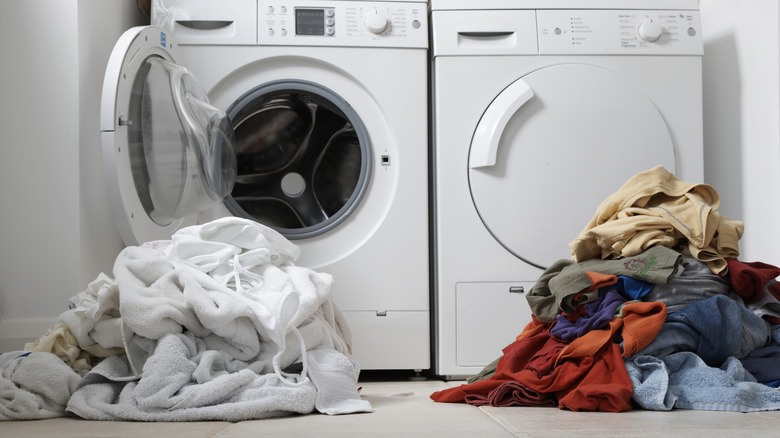What Your Washer's Soil Setting Really Means (And When To Use It)
Have you ever stared at your washing machine's control panel and wondered, what do all the laundry machine settings mean? You're not alone. Most people tend to stick to familiar basic settings, like "normal" or "delicate" cycles, maybe even tweaking the water temperature for different load types. However, modern washing machines are incredibly sophisticated appliances, armed with an artillery of specialized settings designed to make your laundry routine more effective, no matter what you are washing. And, among these are often-overlooked yet super powerful options: The soil level settings.
These aren't a particularly fancy set of options. The settings are a powerful tool that lets you tailor your wash cycle according to how dirty your clothes (or other items) actually are. It is nice to have if you need to wash a bunch of clothes from a lengthy camping trip, or if you have some ripe workout gear that needs a little extra attention. Understanding and properly using your machine's soil level settings can make a world of difference in how clean your laundry gets, and it can even help you conserve energy and water during the process.
Essentially, soil level settings adjust the duration of the wash cycle and the intensity of the agitation. This impacts how much cleaning power your machine exerts and, in some cases, how much detergent you need to use. Logically, it makes sense. That batch of laundry from your camping trip is going to be way dirtier than your everyday clothing and will require more time cleaning, to ensure all the dirt and grime gets out.
How and why to adjust soil level settings
So, why should you bother with the soil level setting? The main reason is pretty clear: It gives you the ability to make sure each laundry load receives the exact amount of cleaning it needs. This prevents both under and over-cleaning. It can help you avoid underfilling your washing machine, too.
For lightly soiled items (this will be something like a pair of jeans you wore just once or a blouse with a faint odor), the lightest soil setting is perfect. This tells your machine to run with a shorter wash time and gentler agitation, using less water and energy to get the job done. On the other hand, heavily soiled items (gardening clothes caked in dirt or uniforms covered in grease) are going to need a heavy or even extra heavy soil setting. Either of these will tell your washing machine to run a longer and more vigorous wash cycle with boosted agitation, giving your clothes a better chance of recovering from tough stains.
Using the correct soil level setting not only gets your dirtiest clothes clean, but also protects your less-soiled garments from unnecessary wear. While the normal default setting is likely the one that will work for the most clothes in the majority of situations, it is nice to know that your machine offers the additional settings necessary for all these different scenarios.
Best practices for soil level success
Mastering your washing machine's soil level setting goes hand-in-hand with implementing a few smart laundry practices that can seriously improve your results. One consideration (as we briefly mentioned above) is adjusting your detergent amount to match the soil level setting you intend to use. For heavily soiled loads, a bit more detergent than you normally use can help by offering up a little more cleaning power for tackling those stains. Likewise, for lightly soiled loads, feel free to scale it back a little bit. Since there will be less water and agitation, this reduction helps prevent over-sudsing and ensures everything is properly rinsed out.
Another excellent strategy is to sort your laundry not just by color, but also by soil level. Instead of throwing all your clothes into one giant load, avoid the laundry mistakes everyone gets wrong and opt to create a separate pile for your dirtiest stuff. Running a dedicated cycle for your grimiest clothes makes sure they receive the intense, prolonged cleaning they require without wasting water on the rest of your gear or overloading your machine. By making these simple adjustments to your laundry routine, you will achieve superior cleaning results and keep your laundry day more efficient and eco-friendly.


